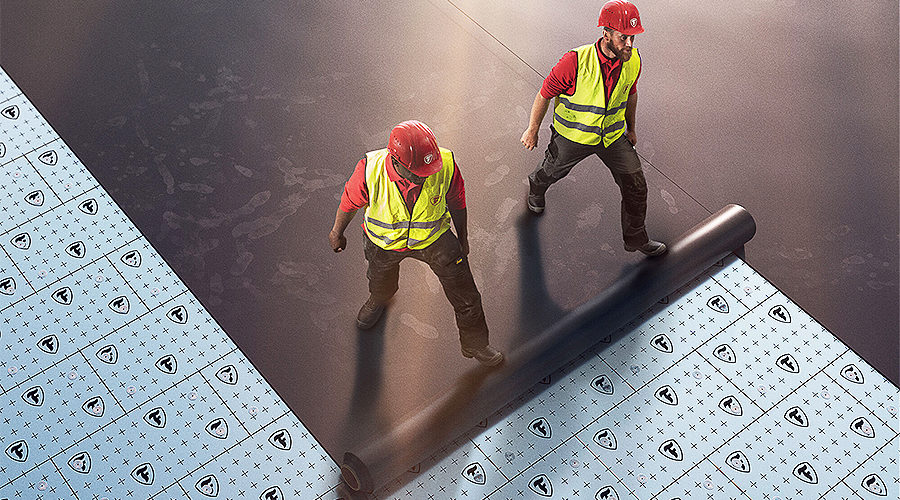Carl Bailey, Regional Technical Manager UK & Ireland for Elevate (formerly Firestone Building Products), explains how an EPDM single-ply roofing membrane can benefit modular school buildings.
Elevate
The use of modern methods of construction (MMC) is rapidly rising, especially across the education sector. The Department for Education’s (DfE) four-year, £3bn Offsite Schools Framework has underlined the Government’s commitment to MMC for new builds. The programme has been targeted to deliver approximately 30 offsite schools a year with many now coming to fruition.
MMC has many benefits, enabling primary and secondary schools to be built faster and more cost effectively, while delivering significant environmental benefits. Advances in technology also mean that modular builds are more durable than ever before. For optimum performance, however, each component of modular design must be carefully planned and the roof is no exception.
As the first line of defence, the roof of a modular school building must be as resilient as possible – and specifying an appropriate waterproofing membrane is a crucial part of the process. Importantly, the correct waterproofing can also drive further efficiencies in MMC and contribute to the building’s environmental credentials.
Ticking all the boxes
An EPDM single-ply membrane is one of the most effective for a modular build. Made from synthetic rubber, the product delivers benefits throughout the construction of a modular building as well as its service life.
To ensure the highest quality standards, each sheet of EPDM is cut to size and applied to the pre-fabricated module in a controlled, factory setting. As the material is single ply, it is lightweight enabling it to be installed quickly and easily.
Safety conditions are enhanced as the EPDM is applied without the need for any hot works in an enclosed space. A RubberGard EPDM membrane, for example, is fully adhered to each module using a solvent- and odour-free adhesive, which can be quickly and safely applied inside a factory.
For any other details that need to be completed in the factory, the self-adhesive QuickSeam range of flashing accessories can be used. The RubberGard EPDM membrane laps the edge of each module so that when the sections are assembled on site, two surfaces of EPDM are mechanically clamped together ready to be sealed quickly and easily with QuickSeam cover strip.
This process allows most of the roofing works to be completed before the modules are delivered to site, avoiding weather-related delays and minimising onsite installation times.
Once adhered, EPDM membranes are immediately waterproof and remain flexible even in extreme temperatures as low as -450°C. This means the modules can be stored outside once completed, freeing up space within the factory.
As the EPDM membrane is made from a synthetic rubber compound, it is also highly flexible and can be elongated by more than 300% without any detriment. If there is any movement or temperature change during the transport of the modular building, this elasticity prevents any damage to the waterproofing.
From an environmental perspective, EPDM can minimise impact in several ways. A membrane, such as RubberGard EPDM, is available in large panel sizes, which means each modular roofing unit can be easily covered with one piece, reducing joints and waste.
EPDM is also a chemically-inert material that does not contain any plasticiser and, when installed correctly, has a life expectancy of more than 50 years.
Futureproofing
Once a modular building has been constructed, the qualities of EPDM will help to protect the structure for many years, significantly reducing the risk of future costs or downtime.
The membrane’s flexibility enables it to return to its original shape and performance after severe weather and makes it resistant to UV, heat, hail and building movements. Minimal maintenance is required and, if needed, the EPDM membrane can be easily repaired using very simple tools, even after several years of exposure.
Should the building need to be altered or expanded in the future, modular units covered with EPDM can be easily dismantled, relocated and sealed back together again, even decades after their initial construction.
Lessons learned
A recent modular build to benefit from an EPDM membrane is Abbey Farm Educate Together (ET) Primary School in north Swindon. The DfE appointed offsite construction specialist Reds10 to design and build the school as part of the Offsite Schools Framework.
Reds10 completed most of the building off site in its factory. Net-zero carbon in design, the school includes a wide range of sustainability features such as air-source heat pumps, photovoltaics, mechanical and natural ventilation, aluminium door and window frames made from recycled materials, floorboards with 50% recycled content and timber cladding.
The RubberGard EPDM membrane was specified by Reds10 for the school’s flat roof. Joe Shepherd, Education Lead at Reds10, commented: “With a desire to reduce carbon emissions during construction, Reds10 swiftly recognised the benefits of RubberGard EPDM. Not only is it a resilient membrane with a long service life, but its flexible structure provides security and protection during the transportation and location of each module onto the project site.
“RubberGard EPDM is also an inert material with low environmental impact, as zero toxic substances are released during and after installation, enabling the collection of runoff rainwater.”
The construction of Abbey Farm ET Primary School began in May 2021 and the new building opened its doors in September 2022. Run by the Educate Together Academy Trust, it caters for 460 pupils and is part of a wider residential-led, mixed-use development by Redrow.
Built to last
Like roofing technology, construction techniques have advanced rapidly in recent years. MMC now delivers both sustainability and value within much shorter timeframes and with EPDM membranes, public sector specifiers and contractors can be assured that the roof of a modular school building will last for decades.












